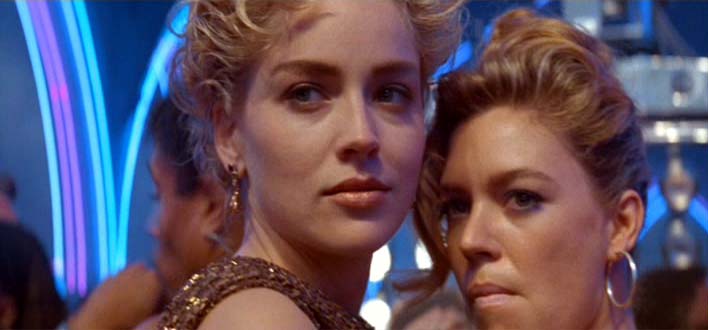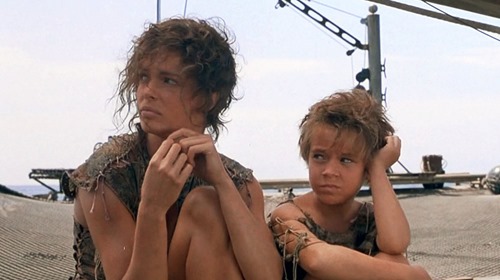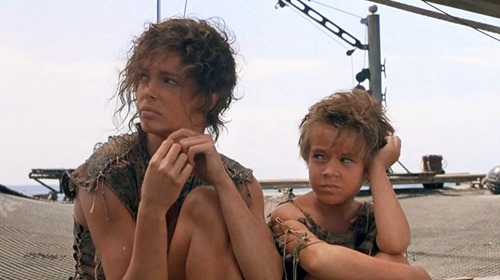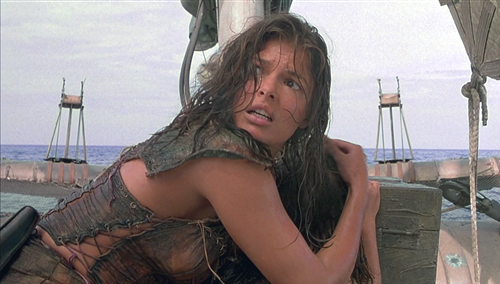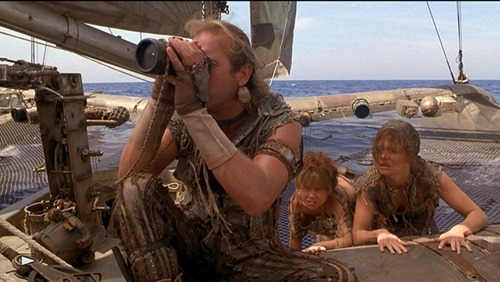This guest post written by L.M. Zoller appears as part of our theme week on Bisexual Representation. | Spoilers ahead.
[Trigger warning: discussions of biphobia and mentions of sexual violence.]
Director Paul Verhoeven desperately wants Basic Instinct to be an updated Hitchcock classic (not that Hitchcock was so great on the “evil queer” angle either), taking the psychosexual element to the MPAA limit for 1991, but he clearly forgot that biphobia and “edgy” sex scenes make for a terrible thriller. The film is extremely biphobic and includes many of the most negative stereotypes about bisexuality, particularly in terms of bisexual women: that bisexuality is fake, particularly in the sense of heteronormativity and sapphophobia; conflating bisexuality with mental illness; that queer women exist for the male gaze; and the idea that queer women “recruit” straight women. All this, and the word “bisexual” is never even uttered once.
At the beginning of the film, Detective Nick Curran (Michael Douglas) has been called in to investigate the murder of aging rock star Johnny Boz, whom we see being tied to a bed and stabbed to death with an ice pick by a blonde woman whose face we never see. The primary suspect is Boz’s eventual girlfriend Catherine Tramell (Sharon Stone), a novelist who writes murder mysteries; her latest novel was about an aging rock star murdered in the exact fashion Boz was. Nick falls into instant lust with Catherine but isn’t sure if she’s the killer; Catherine decides to write a book about Nick, about “a detective who falls in love with the wrong woman.”
One of the issues with queer representation in media is that tokenism creates the burden of representation: the one character must then represent all of queerdom — and none of its intersections or the diversity of LGBTQIA+ experiences. Thus, including more queer characters ought to offset the burden and allow the creators to show a diversity of personalities, gender expressions, and lived experiences, as well as intersections with socioeconomic status, race, ability, etc. Basic Instinct manages to have not one but three queer women characters, including two canonically bisexual ones, and they all are written as stereotypes.
The queer community protested the film in 1991-2 during the filming and release for exactly this reason. In the article “Homosexuals In Film: The Controversy Gay Activists Say ‘Basic Instinct,’ Opening Friday, Is A Perfect Example Of What Is Wrong With Hollywood’s Vision,” journalist and film critic Lewis Beale collected the same comments from activists that we’re still making in 2016 regarding better representation of queer characters, especially non-monosexual and trans characters:
“There has been a nonstop, decades-long portrayal of gays as psychopaths, sociopaths and screaming queens,” says Robert Bray of the Washington-based National Gay & Lesbian Task Force. “I don’t mind a gay villain or two, but I also wouldn’t mind a gay or lesbian hero. No one is calling for cultural censorship, but we are asking for diverse representations.”
….As Leonard Maltin, the film historian who appears on Entertainment Tonight, puts it: “If gays are frequently portrayed on film, then the fact that some are villains isn’t going to matter. But when you see them infrequently, then each portrayal carries a disproportionate amount of weight with the audience.”
(Please note that some of the language in this article, including quotes by activists, does not include the term bisexual.)
Catherine Trammel is a bisexual, polyamorous, possibly aromantic novelist who specializes in murder mysteries that happen to come true. Let me be clear that this film does not paint Catherine as the hero or even the anti-hero, but rather as a hypersexualized sociopath. The detectives are incredulous that she wasn’t in love with Johnny Boz but had a long-term sexual relationship with him, which she initiated to write her novel and maintained because she enjoyed sex with him. Catherine is supposed to have this cat-and-mouse sexual tension with Nick, but it rings false: she actually seems to be calling him out on his heterosexism by talking back to him. However, because the film conflates bisexuality with psychopathy, her flippant remarks to Nick Carran are supposed to be interpreted as the evil queer woman using her sexuality to goad the heroic everyman character into ruining his life for her. For example, when Nick announces that the sex they just had — exceedingly heteronormative fare other than the fact she ties him up like Boz — was the “fuck of the century,” Catherine laughs at him and says it was “a pretty good start.” He thinks he’s God’s gift to women; she’s clear with him several times that their relationship is a means for her to write her detective novel.
Catherine’s refusal to even acknowledge Nick’s puffed-up male-privilege-steeped ego enters into both of their relationships with the second queer character in the film, Roxy (Leilani Sarelle). Roxy is Catherine’s girlfriend; she is only shown as Catherine’s partner and barely has any lines at all, so it’s unclear if she is also bisexual or if she identifies as a lesbian. Roxy is portrayed as a tomboy femme and a different stereotype — the jealous lover who is ousted by a straight man. In the scene prior to the sex scene, Nick picks up Catherine in a club. Everyone looks fabulous and fierce, especially Roxy and Catherine; Nick walks in wearing a dad sweater and jeans. Catherine picks him to go home with instead of Roxy in what feels like a heavy-handed metaphor for compulsory heterosexuality. He merely has to show up and ham-fistedly grab her butt for her to be more interested in him than in Roxy.
When Roxy confronts Nick in the bathroom after Catherine and Nick have had sex, Roxy claims Catherine likes her to watch her have sex; when Catherine confirms that Roxy likes to watch, the following exchange happens:
Nick: I guess Roxy’s not taking this too well.
Catherine: She’s seen me fuck plenty of guys.
Nick: Well, maybe she saw something she’s never seen before.
Catherine: She’s seen everything before.
Nick: Honey, I thought I’d seen everything before.
Catherine: Did you really think it was so special?
Catherine rebukes him at every turn about her relationship with Roxy; Nick continues to mansplain her own relationship to her. However, Roxy really is angry with him and tries to run him over with her car as he exits a bar. He chases her in his car, eventually running her off the road, and killing her in a classic case of dead lesbian/bisexual syndrome. She never got jealous about other men, according to Catherine, but Nick is so special that apparently she has to murder him, picking up the tropes of jealous partner, murderous queer woman, and angry (soft) butch all in one go.
The final queer woman character is Dr. Beth Garner (Jeanne Tripplehorn), who fulfills the stereotype of a straight woman “recruited” by (murderous) queer women or the murderous closet case. Beth is a psychologist working with the San Francisco Police and acting as Nick’s psychologist after an incident where he shot several tourists by accident. She slept with Catherine in college; she had a relationship with Nick and used to be married to another man; a former acquaintance tells Nick that Beth’s marriage dissolved because she had a girlfriend. However, when Nick questions her about sleeping with Catherine, Beth claims that she isn’t queer: “Hey, guys, I’m not gay, but I did fuck your suspect? I was experimenting; it was the only time I’ve been with a woman.” Immediately after, she says, “She’s really sick you know,” and claims that Catherine was stalking her in college, which counters Catherine’s claim that Beth was obsessed with her.
Of course, Beth’s fear of being out at work or being connected to the suspect isn’t unmerited. Whereas Catherine, a mystery writer, remains unaffected in her career by her sexuality and sexual history, Beth might not be taken seriously as a psychologist or in law enforcement if she were out as bisexual, and coming out to a room full of men who can barely understand a woman having sex for pleasure seems like a nightmare. Instead of using this plot line as a vehicle to discuss bi erasure, the need for LGBTQIA-inclusive ENDA or anti-oppression training, or the concept of bisexuality as who you are, not whom you’re with, the film just conflates her sexuality with psychopathy. She and Catherine both accuse each other of stalking, and Beth is later revealed or framed (?) as the murderer. Like Roxy, Beth is also killed by Nick, who shoots her because he thinks she has a weapon.
Throughout this whole film, no one ever says the word bisexual. Catherine doesn’t discuss her sexuality at all but discusses past and present partners of same and different genders without hesitation. Roxy barely gets to speak, let alone discuss her sexual orientation. Beth claims not to be “gay” (which could be read as either a 90s umbrella term or as lesbian-identified/monosexual). The lack of inclusion of the term is just the cherry on the biphobia sundae that is Basic Instinct.
It’s also important to note that of the three women, only Catherine survives. Are both Roxy and Beth dead because they refused to do what Nick, the cishet man, wanted? Or, if the film is actually Catherine’s novel Shooter, did she or Nick tack on the “happy ending” at his request instead of having the “wrong woman” murder him?
Nick is a biphobic, mansplaining rapist (trigger warning: there is a scene in which Nick and Beth are having consensual sex where she tells him to stop and he doesn’t) with an inflated ego and anger management issues who is decidedly not redeemed in the narrative of the film. While he had tried to redeem himself after committing violence prior to the start of the film, he got sober but didn’t work on any of his numerous issues with male privilege, rape culture, or monosexism. From a bisexual lens, the element of horror in this film is not that Catherine or Beth might be a murderer, but that Nick is supposed to be the hero.
See also at Bitch Flicks:
The Trope of the Murderous Bisexual Woman
L.M. Zoller is a genderqueer bisexual writer living in Seattle. Ze write the blogs I’ll Make It Myself!, about food and gender, and The Lobster Dance, a blog about about geekery and gender, featuring the annual Feminist Halloween series and The Non-Binary Book Club. Zir work has been published in Render: Food and Culture Quarterly (forthcoming Fall 2016), Feministe, and Have You Nerd?.
